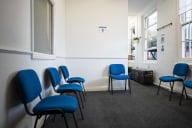You have /5 articles left.
Sign up for a free account or log in.
Faye Barrett, a student at the University of Maryland at College Park, was preparing to leave the hospital a couple weeks ago after checking herself in for a panic attack. She had spent much of the morning hospitalized and was looking forward to resting in her campus apartment when she noticed an email from the university.
It informed her that she wasn’t allowed back -- she needed to be evaluated over concerns about her “ability” to live in campus housing.
She shared the letter online, and backlash was immediate over the institution’s response, which many perceived as cold to a student who was being responsible in addressing her mental health needs. Administrators have since started to reconsider how they communicate to students in crisis.
Experts say there’s no universal solution in these scenarios, but that colleges generally aren’t trying to punish -- they only want to ensure student well-being.
Maryland is being criticized for overreacting or being insensitive, but other institutions have been slammed and in some cases sued for allegedly not intervening during mental health crises. The family of a MIT student who ended his life in 2009 filed a lawsuit against the institution, asserting administrators and faculty knew of his mental problems and should have taken steps to prevent the suicide. It works the other way around, too. Princeton University was sued by a student who alleged he shouldn't have been blocked from his dormitory or made to leave campus after a suicide attempt.
“One of the reasons why we have a protocol like this is that we want to make sure that the student is safe,” said Sharon Kirkland-Gordon, Maryland’s counseling center director.
Still, Maryland students have campaigned for nearly two months over a perceived lack of mental health resources on campus, and Barrett’s case has fueled that debate.
Barrett did not respond to request for comment but detailed her story in an op-ed to the student newspaper, The Diamondback.
She wrote that she has been diagnosed with bipolar disorder and has struggled with depression and anxiety. During an episode, she was convinced that she overdosed on muscle relaxants and called to be taken to the hospital.
After Barrett calmed down and was released, she read the email from an administrator in residence life, which she said she received about 4:30 a.m., before she was discharged.
“Based upon the information I have received about this incident, I have concerns about your ability to successfully manage living in a residence hall,” the email says -- the second sentence of the letter. “The purpose of this letter is to ensure that you understand the expectations concerning our ability to return to living in your on-campus residence hall upon your discharge from the hospital.”
The email states that Barrett would need to meet with both the mental health center and a residential case manager before being permitted back in her apartment.
Barrett posted the letter and a tirade against the university on both Twitter and Facebook. Her tweet has since been retweeted more than 2,600 times and liked nearly 4,400 times. On Facebook, it was shared more than 370 times.
“Already overwhelmed from the night and running on two hours of sleep, I uncontrollably sobbed in the corner of the emergency room,” Barrett wrote in The Diamondback. “I wanted the stability and comfort of my own bed. I wanted to feel safe, and suddenly I was robbed of that.”
She added later, “After an event like hospitalization, there should be comfort and love, not a policy that could trigger a dangerous or unhealthy response. It takes strength and bravery to get help for a mood disorder, and instead I was punished.”
The note Barrett received was the university’s standard response to students hospitalized for mental health-related matters and was meant to motivate students to seek out treatment, not fall back into a routine and ignore their mental health, according to university officials. But it has since been rewritten. The procedures are still in place -- no returning to campus housing without an evaluation -- but the revised correspondence offers a kinder introduction:
“We understand that this may be a very difficult time for you. This letter is in regard to the incident that occurred [on date]. The purpose of this letter is to ensure that you understand the resources available to you and the expectations concerning your return to on-campus housing.”
This is an interim version of the letter -- a work group has been formed with the counseling center, residence life and three students to discuss it and how the university’s policies should be reworked.
“The protocol we have applied when residents are transported to the hospital due to mental health-related crises has been effective in getting students to the most appropriate resources who can help during and after a crisis situation,” Deb Grandner, director of resident life, said in a statement. “Our goal and practice are not to remove students from their homes on campus.”
In an interview, Kirkland-Gordon said she could not comment on the language of the letter, which was drafted by residence life administrators, but she said that she felt the university having already reviewed it shows its commitment to mental health.
She said the committee will focus on making sure students are properly assessed so they can continue to successfully and independently live in the residence halls.
“It’s really most important to have enough resources and ensure their success here, especially during their recovery,” Kirkland-Gordon said.
Some students are unconvinced the university can provide them the mental health resources they need.
Members of a student group, Scholars Promoting and Revitalizing Care, started a campaign last month, “30 Days Too Late,” named for the amount of time they allege it takes to see a university counselor.
Alyssa Schledwitz, the group’s vice president, told Inside Higher Ed many students were “outraged” by what happened to Barrett. University counselors try to help the students in need, but they are overloaded and wait times for the counseling centers can often be weeks, she said.
Maryland recently agreed to hire three new counselors, which would increase staffing in the center to 20 people for a campus of more than 28,400 undergraduates.
“We want a holistic view of the student to be part of UMD’s policy,” Schledwitz said of the committee’s work. “They have the potential to be a leader among universities and have more transparency with their mental health statistics, from the counseling center and the health center. We want there to be more preventive measures before students reach crisis, too.”
There doesn’t appear to be one set way institutions handle reintegrating a student after a hospitalization.
Hospitals will release someone after they determine the patient isn’t a threat to themselves or others -- which is the standard for people “rejoining” their communities, said Sharon Mitchell, president of the Association for University and College Counseling Center Directors.
But institutions aren’t always just concerned with imminent safety, Mitchell said. They want to make sure a student can continue their academics and function in a campus housing -- a space for both living and learning. To that end, some colleges and universities might require, as Maryland did, a meeting with a counselor or an administrator.
“The primary goal is helping students develop a plan for getting back on track for success in a college environment. It is not meant to be punitive,” Mitchell said, adding that in some rarer cases, students aren’t allowed back in a dorm because they were repeatedly disruptive or violated a university’s conduct code.
Lisa Adams, president of the American College Counseling Association, noted that federal law prohibits institutions from discriminating against students based on disability, which would include kicking them out of housing. But this doesn't apply if a student is disruptive to campus or they could be a threat to themselves or others.
“The decision about if a student is safe to return to living on campus should be made on a case-by-case basis, using a team of interdisciplinary professionals making sure, to the best of their ability, that the student is safe from harm to self or others,” Adams said.








